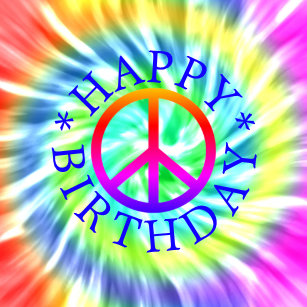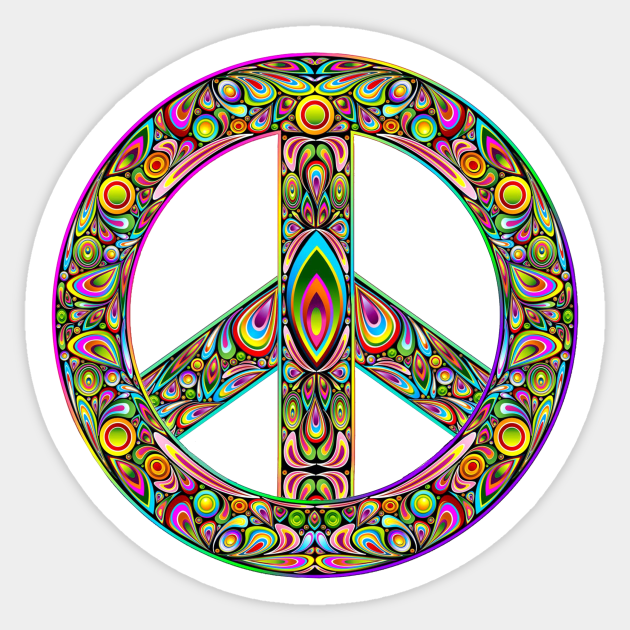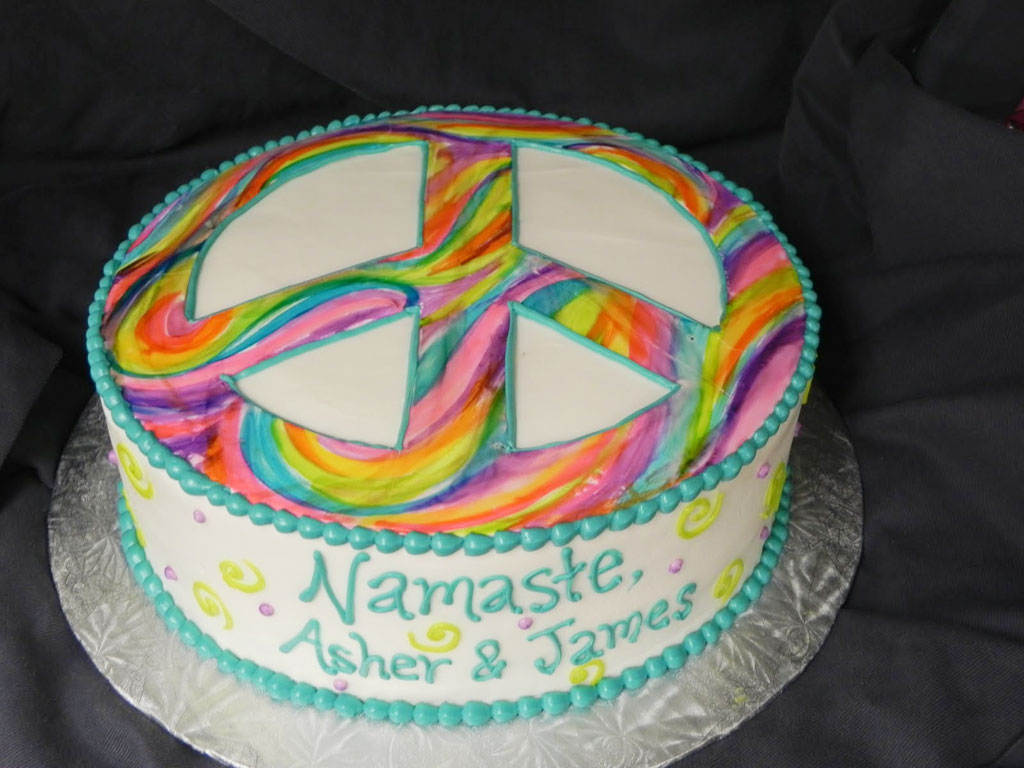
At Sixty-Five, The Peace Symbol Endures;
Peace Not So Much
Bill Berkowitz / Daily Kos Community
(February 21, 2023) — Banksy used it in an art piece; German soccer players wore it on their uniforms to protest the Russian invasion of Ukraine; kids in Canada decorated cupcakes with it during its annual fundraising drive. At sixty-five, the Peace Symbol survives. Peace, on the other hand, not so much!
Sixty-five years ago, British artist Gerald Holtom created the peace symbol. Despite charges of being a symbol of communism, Satanism, and even Nazism, the peace symbol, created for anti-nuclear protests in the late 1950s, endures.
The peace symbol, now ubiquitous throughout the world, created on February 21, 1958, was first seen in public on Good Friday of that year – which fell on April 4 — when thousands of British anti-nuclear campaigners — organized by the Direct Action Committee Against Nuclear War (DAC) and the Campaign for Nuclear Disarmament (CND) — marched 52 miles from London’s Trafalgar Square to the Atomic Weapons Research Establishment at Aldermaston in Berkshire.
Gerald Holtom, a British artists and designer, and World War II conscientious objector, created the peace symbol out of feelings of deep anguish. In an interview with Peace News, Holtom said:
“I was in despair. Deep despair. I drew myself: the representative of an individual in despair, with hands palm outstretched outwards and downwards in the manner of Goya’s peasant before the firing squad. I formalized the drawing into a line and put a circle round it.”
BBC News reported that Holtom “considered using a Christian cross motif but, instead, settled on using letters from the semaphore — or flag-signaling — alphabet, super-imposing N (uclear) on D (isarmament) and placing them within a circle symbolizing Earth.”

In his book The Disarmers: A Study in Protest, Christopher Driver, wrote that Holtom created the design and then brought it to an organizer of a local British peace group. After several revisions, it was unveiled publicly on Good Friday of that year, at the first Ban-the-Bomb March. Driver, a pacifist, described it as “probably the most powerful, memorable and adaptable image ever designed for a secular cause.”
In the US, civil tights movements first used the peace symbol. CNN noted that “It was probably imported by Bayard Rustin, a close collaborator of Martin Luther King Jr., who had participated in the London march in 1958. Crossing the Atlantic, the symbol lost its association with nuclear disarmament and came to signify, more generally, peace.”
CNN pointed out that “As the Vietnam War escalated in the mid-1960s, the peace symbol was adopted by anti-war protesters and the counterculture movement, finding its stereotypical place on Volkswagen buses and acid-wash T-shirts. Intentionally kept free from copyright, it traveled far and wide, appearing in the former Czechoslovakia as a symbol against Soviet invasion, and in South Africa to oppose Apartheid.”
Over the years, the peace symbol — which Holtom created without a copyright – has been visible at protests on buttons, posters, painted faces, and flags. Artists around the world have used it in a myriad of ways. Banksy, who created guerilla art—consisting, among other things, of stencils, temporary installations — used the peace symbol in a work where two soldiers surreptitiously paint a peace symbol on a wall.

Last March, Goal.com reported that “The Bundesliga [soccer] club sent out a strong message amid the ongoing crisis in Eastern Europe and plan to raise funds to help those affected
Bundesliga side Wolfsburg displayed the peace symbol inside their centre circle on Saturday amid Russia’s invasion of Ukraine.
“And along with their pitch tribute, Wolfsburg also wore the iconic peace symbol on their shirts, instead of the logo of long-time sponsor Volkswagen, as they took on Union Berlin.”
This year, in celebration of African Heritage Month, Delectable Desserts, a bakery in Dartmouth, Nova Scotia, had students design cupcakes – several of which were topped with peace symbols — whose proceeds from the sales are donated to local initiatives that are working to bettering the future for black youth in the city.
The peace symbol has been rigorously commercialized; gracing jewelry, lunchboxes, t-shirts, dresses, raingear and other assorted paraphernalia. It even appeared on a jumpsuit worn by Missy Elliott during a Super Bowl half-time show.
At the time, I wrote: “While it may be a little incongruous/bizarre in this age of US acts of war, terrorist beheadings, US Drone strikes and other acts of state and non-state violence to think about the Peace Symbol, Elliot’s outfit reminded me that fifty-seven-years after its creation, the Peace Symbol is still found even in the most unlikely of places, i.e. the National Football League’s 49th Annual Super Bowl.”
The peace symbol has also been the target of right wing and religious activists: As the Durango Herald’s Thomas Munro reported, “During the Cold War, as a symbol of the peace movement and the left, it was immediately defined by many as a symbol of communism.

The geometrical similarity of the interior of the symbol to an upside-down cross was fodder for anti-communists who saw in the symbol a subliminal promotion of atheism. Others pointed out that a similar symbol appears on the tombstones of some Nazi bomber pilots.”
In October 1970, Ezra Taft Benson, the 13th President of the LDS (Mormon) Church, former US Secretary of Agriculture, and an admirer of the far-right John Birch Society, trashed the peace symbol in a speech at General Conference:
“Have we… ‘polluted the holy church of God?’ …. The auxiliaries of the Church are to be a help, not a hindrance, to parents and the priesthood as they strive to lead their families back to God. Do any of us wear or display the broken cross, anti-Christ sign, that is the adversary’s symbol of the so-called ‘peace movement’”?
Benson “was evidently parroting over the pulpit the political fear-mongering propaganda that had been published by the John Birch Society (in their official publication American Opinion) only four months before,” the blog culturalmormoncafeteria pointed out.
Titled “Peace Symbols: The Truth About Those Strange Designs,” the American Opinion article “associated” the peace symbol “with a broken cross, Communism, [the] anti-Christ, and Satanism.”
In addition to falsely claiming that the famed British philosopher, mathematician, and peace activist Bertrand Russell had designed the symbol, author David E. Gumaer, who later published a book with the same title, wrote: “It was the upside-down broken cross. Such anti-Christian and anti-Jewish symbolism is common to Satanists…
“The revolutionaries are pushing this business [of Satanism and black magic] like there’s no tomorrow. And those ‘peace symbols’ are a part of it. They are symbols of the anti-Christ!…”
In the epilogue to Peace: The Biography of a Symbol (National Geographic, 2008), Ken Kolsbun and Mike Sweeney wrote: “Children of today easily identify it. They may not know its original meaning, but they know it stands for good things – be nice to friends, be kind to animals, no fighting.

“This is a marvelous achievement for Gerald Holtom’s simple design. Peoples around the world have marched with it, worn it, displayed it during combat, held it high on banners, and been arrested in its name. Ask any man, woman or child, ‘What one thing would everyone in the world want more than anything else?’ The answer would surely be world peace.’”
Gerald Holtom died in 1971, at age 85. It is doubtful that people wearing the peace symbol, using the peace symbol in drawings, or carrying the peace symbol at demonstrations have any idea who Holtom was, or under what circumstances the symbol was created. According to The Guardian’s Ian Jack pointed out that Holtom “never made a penny from his design or wanted to.”
Posted in accordance with Title 17, Section 107, US Code, for noncommercial, educational purposes.